Himeji
We saw the box on the hill as we headed west to Hiroshima and now we saw it again as the Shinkansen pulled into Himeji station on our way back east. We would have passed it both times if the desk clerk at the module hotel in Kyoto had not been so insistent that we stopped. In particular we needed to reserve a spot on one of the guided tours that would give us access to the Egret's Eye View.
Once down on street level all signs of the castle seemed to disappear, and stayed hidden until we were close enough to pay our money and entered the grounds. A courtesy bus was just leaving the station so we jumped on, and five minutes later it dropped us nowhere near the main entrance, though it was an attractive enough walk towards what we assumed had to be the way in. But having crossed the bridge and passed through the portal, into San-no-Maru, the third bailey, it became clear we were still only about half way there.

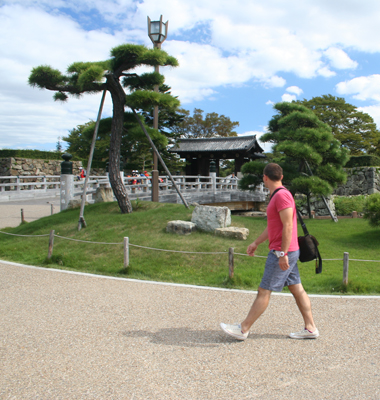
 As usual, the literature assured us that San-no-Maru would be a stunning view in cherry blossom season. But so far, not so good. No blossom, no grass, a box for a castle. The silhouette of what we were missing on the side of the box was pretty neat though.
As usual, the literature assured us that San-no-Maru would be a stunning view in cherry blossom season. But so far, not so good. No blossom, no grass, a box for a castle. The silhouette of what we were missing on the side of the box was pretty neat though.
Eventually we arrived at the Hishi Gate where we were supposed to announce ourselves and our reservation. We could have sworn that we had been asked to give a language preference, and when we were shuttled off about ten minutes earlier than we expected with a bunch of grandmas and a guide none of whom had any more English than I had Japanese, Adam even ran back to the start to see if there had been a mistake. Nope. So off we went, following the exact path that our English-language pamphlet mapped out for all visitors.

| For all the accolades afforded other sites we visited, Himeji was Japan's first UNESCO World Cultural Heritage site. As its brochure rightly boasts, the castle's beauty and level of perfection are the greatest of any wooden structure in Japan. The keeps, towers and walls, have been remarkably well preserved for over 400 years. The site is famous for showing the unique defensive methods of Japan's feudal era. It is the largest, and no surprise the most visited castle in Japan. Putting the other value indicators in perspective, Himeji also comprises 8 separate National Treasures, and no less than 74 important cultural properties. |
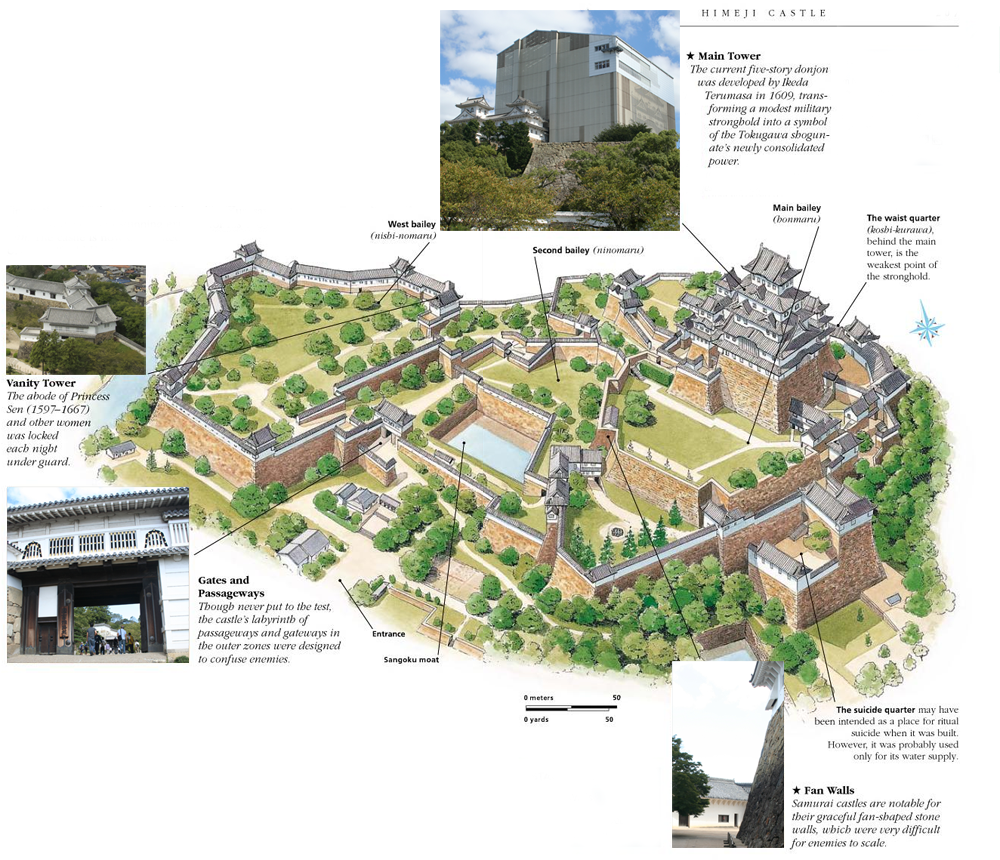
| With our own map, the human guide was completely useless. But we stuck with him for a while for two reasons. First and foremost, we were not sure if he and he alone would be able to grant us access to the Egret's Eye View, which after all was what we'd been assured was the real draw. Second, we were highly amused by the rest of our flock. There must have been about a dozen of them, and not one of them were more than chest height, despite our own faily modest altitude. Every time the guide said something to them, in unison they would all make some exclamation. Oooooh! Ohhhhhh! Ahhhhh! (So) Ewwwwh! RT: "What the heck is this reminding me of?" Adam: "Despicable Me minions" Yes! A couple even had bottle-bottom glasses. |
Below is the Hishi (Diamond) Gate, then random views of the castle and its walls, including the sama, windows designed to give bowmen more flexability than the incoming projectiles. I'm very familiar with this from visits to buildings all over the place, but it always seemed to me that anyone on the inside of a structure with thick walls would do that just for the totally benign reason of being able to see more. Heck my parent's house is only 40 years old and it has them, and the only arrows I ever saw were my mother's silent condemnation of some enterprise we were foolish enough to attempt within her purview.

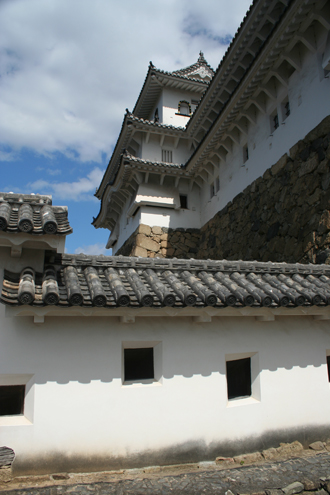

The guide showed us the fan-sloped stone walls, which are not only attractive but difficult to scale, and he pointed out some of the stone coffins that for some reason ended up in the wall instead of the purpose for which we assume they were originally intended. Perhaps a clue is provided by Aburakabe, a millstone also built into the walls, and reputed to have been donated by a poor woman even though she needed the stone to make her living. She is said to have heard that Hashiba Hideyoshi, the 16th century lord who commissioned the castle, was in need of stone. On hearing her story, other people brought enough stone to complete the walls. So maybe they really were just that desperate.
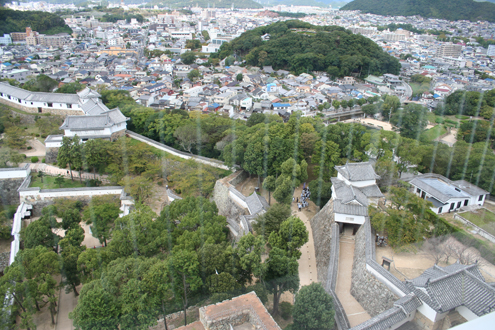
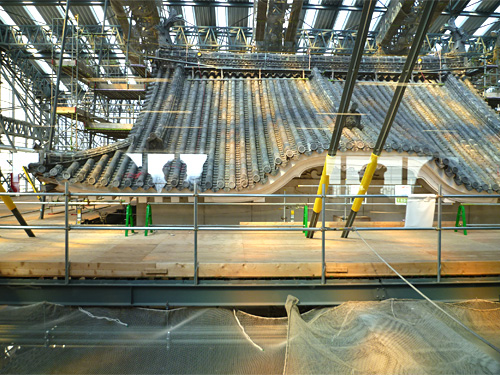
Best of show in this section, and again thanks to this restoration period visit, a unique opportunity, was a small display of the shachi-gawara which would normally be perched on the roof corners. Fish with the head of a tiger, these mythical beasts were believed to protect the keep from fire. This seems reasonable, since they were also fitted over the end of the gutter, so rain water spews from their throats (they actually face in, "swallowing" the water).
Finally we entered the base of the box where there was an exhibition hall, but even the native's were restless so we were soon in line for the Egret's Eye elevator. And here is where the adventure began. The inside wall of the elevator (facing the keep) was all glass. And right outside the glass not a yard away was the foundation of the keep wall. I felt like Spiderman effortlessly scalling the wall as we rose. At about the third floor, the stonework switched to the white plaster which is such a striking feature of the castle. The 'vator does not stop until the 7th floor where you can see the wall restoration in progress, and then the jewel in the crown, the 8th floor provides a view of the roof restoration.
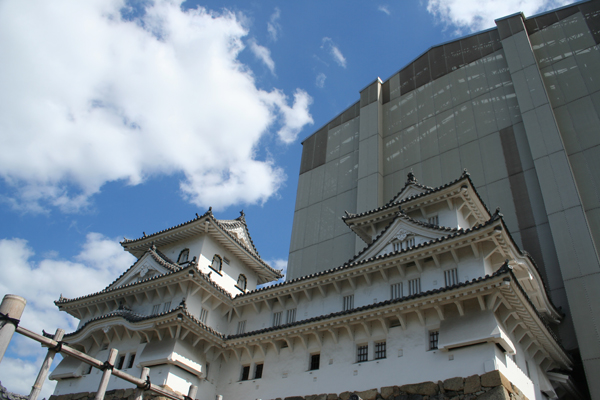 Wow. I was totally unprepared for how great this was. In addition to providing a remarkably secure and weatherproof environment for the workers to move around in, and despite the feeling of comfort and safety this provided for us gawkers, there was still this remarkable sense of being in an unnatural place, hovering 30 feet from the roof top of a castle perched on top of its own mound on top of a hill. An Egret's Eye view indeed. If I lived in Himeji I think I would have come every week in the five years the keep was covered in this way, just to watch the workers take it all apart and put it all back together again.
Wow. I was totally unprepared for how great this was. In addition to providing a remarkably secure and weatherproof environment for the workers to move around in, and despite the feeling of comfort and safety this provided for us gawkers, there was still this remarkable sense of being in an unnatural place, hovering 30 feet from the roof top of a castle perched on top of its own mound on top of a hill. An Egret's Eye view indeed. If I lived in Himeji I think I would have come every week in the five years the keep was covered in this way, just to watch the workers take it all apart and put it all back together again.
It didn't matter a hoot that we were therefore unable to tour the inside of the building. We can come back again another day for that. This was a truly once in a life-time opportunity. And we caught it just in time: the restoration project was due to close on Jan 15 2014 (just four months away) and the main tower will not reopen until March 27 2015.
When I peeled my nose off the glass to catch my breath for a moment, a docent approached and started transmitting in English. As good a guess as any I suppose. At this point we were looking through an outside window (above left) and whether I wanted to listen or not she just set off to describe what I was looking at. What I was really looking at. See that long passage down there? The walls gradually close in, so that a rushing group of invaders who start off with enough room to move quickly find themselves crushed together. That one over there? See it looks like it is going somewhere useful, but after they turn that corner they find there is no exit, so they are trapped. The usual flights of stairs with the risers all at different heights so that you can't run up them without falling flat on your face. And there is the "Vanity" tower where Princess Senhime (1597 - 1667) was quartered.
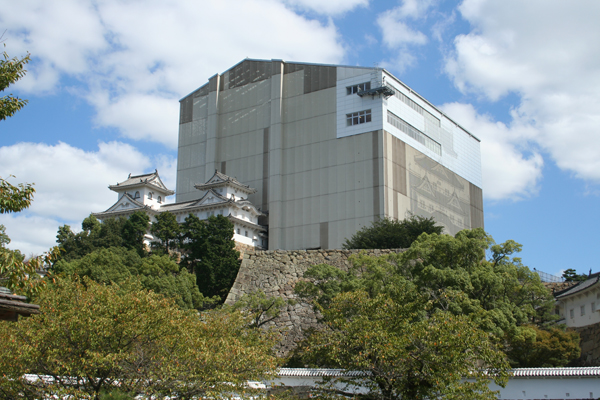 The main keep to which we were being denied access this time around, had its fair share of surprises too, the most memorable of which is that there are more floors on the inside than there appear to be from the outside.
The main keep to which we were being denied access this time around, had its fair share of surprises too, the most memorable of which is that there are more floors on the inside than there appear to be from the outside.
But that will have to wait until next time. Back on the ground, we continued to follow the recommended route, now free of our guide and the minions. Below left is the North Koshikuruwa Storehouse, which I only snapped because I liked the view, but only can name because it turns out to be featured on the backside of the brochure map. It is "in the form of a beautiful arc following the steeply-sloped stone wall" (seriously? That's not what the map shows, but this was definately the view they were talking about. It stored salt, rice "and other foodstuffs" in case the castle was besiged.
We took the extended route through Nishi-no-Maru. RT: "Hey! Nishi means west, and the other baileys were something-no-Maru, so this must be the west bailey!" Adam: "Yes pops." Small victory I guess. This afforded us a great view of the box, but otherwise was nothing to write home about. But finally, just as a reminder of the glory what we were missing, below right is a shot stolen from the interweb, standing in pretty much the same position. Fabulous.


Time to move on. But not before stopping at an ice-cream vendor where I bought my favorite sweet of the trip: a sugar cone with green tea ice cream. What I did not notice until I bit into it was that the ice-cream had whole red beans embedded in it. Very strange, but very delicious. We walked back to the station, retrieved all our bags from the lockers, and as usual had about a five or ten minute wait before the train to Nagoya, and the next leg of our adventure: the weekend with Adam's friends Alistair and Maiko-chan.